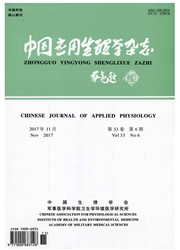

 中文摘要:
中文摘要:
目的探讨内科重症监护病房(MICU)患者撤机困难的相关因素。方法回顾分析2010年4月至2011年4月收治的112例接受呼吸机辅助通气患者的临床资料,其中男63例,女49例,年龄(58±26)岁;基础疾病主要包括慢性阻塞性肺疾病急性加重(AECOPD)27例、肺炎20例、哮喘12例、神经肌肉疾病8例等。记录患者入院时基本情况、基础疾病、伴随疾病情况及撤机前的生理指标变化。将患者分为成功撤机组和撤机困难组,应用Logistic回归分析等分析与撤机困难有关的危险因素。结果撤机困难患者共27例(24.1%),其中基础疾病在两组间的分布差异有统计学意义的是:AECOPD(χ^2=6.238,P=0.028)、特发性肺纤维化(χ^2=5.232,P=0.025)、神经肌肉疾病(χ^2=14.635,P=0.007),撤机困难比例分别为9/27、2/6、6/8;两组间入院时氧合指数及撤机前氧合指数差异均有统计学意义(t=2.183,2.162,均P〈0.05);两组间撤机前的Zubrod评分差异有统计学意义(t=9.037,P〈0.05);Logistic回归结果显示:严重心功能不全、精神心理疾病、阻塞性睡眠呼吸暂停、AECOPD及神经肌肉疾病的患者更易出现撤机困难(OR值分别为5.781、4.654、4.012、3.617及2.885)。结论严重心功能不全、精神心理疾病、阻塞性睡眠呼吸暂停、AECOPD、神经肌肉疾病是MICU患者撤机困难的主要危险因素;患者的氧合功能以及自主行为能力也对撤机产生影响。
 英文摘要:
英文摘要:
Objective To explore the related factors of difficult-to-wean patients in medical intensive care unit (MICU). Methods A retrospective analysis was performed for 112 patients placed on mechanical ventilation. There were 63 males and 49 females with a mean age of (58 ± 26) years. Their primary diseases included acute exacerbation of chronic obstructive pulmonary disease (AECOPD) (n = 27 ), pneumonia ( n = 20) , asthma ( n = 12) and neuromuscular diseases ( n = 8 ). Basic admission profiles, underlying diseases, accompanying diseases and pre-weaning changes in physiological indicators were recorded. They were divided into 2 groups: successfully-weaned group and different-to-wean group. Logistic regression analysis was used to analyze the risk factors correlated with the difficult withdrawal of mechanical ventilation. Results There were 27 (24. 1% ) difficult-to-wean patients on mechanical ventilation in MICU. Some underlying diseases had statistical significance in both groups, including AECOPD ( χ^2 = 6. 238, P = 0. 028 ), idiopathic pulmonary fibrosis ( χ^2 = 5. 232, P = 0. 025 ) and neuromuscular disease (χ^2 = 14. 635, P = 0. 007 ). The ratios of difficult-to-wean patients were 9/27, 2/6 and 6/8 respectively. There was statistical significance of pre-admission and pre-weaning oxygenation index between two groups ( t = 2. 183, 2. 162, P 〈 0. 05 ). Zubrod score at pre-weaning was also significantly different between two groups ( t = 9. 037, P 〈 0. 05 ). Logistic regression indicated that the patients with severe heart failure ( OR = 5. 781 ) , psychological disorders ( OR = 4. 654 ), obstructive sleep apnea ( OR = 4. 012 ), AECOPD ( OR = 3. 617 ) and neuromuscular diseases (OR = 2. 885 ) were more vulnerable to weaning difficulties. Conclusion The major risk factors of difficult-to-wean patients in MICU include severe heart failure, psychological diseases, obstructive sleep apnea, neuromuscular disease and AECOPD. And oxygenation and
 同期刊论文项目
同期刊论文项目
 同项目期刊论文
同项目期刊论文
 期刊信息
期刊信息
